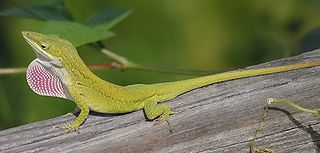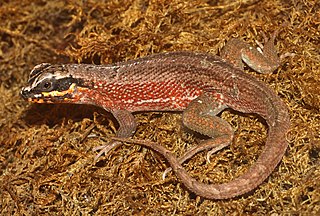
Dactyloidae are a family of lizards commonly known as anoles and native to warmer parts of the Americas, ranging from southeastern United States to Paraguay. Instead of treating it as a family, some authorities prefer to treat it as a subfamily, Dactyloidae, of the family Iguanidae. In the past they were included in the family Polychrotidae together with Polychrus, but the latter genus is not closely related to the true anoles.

The Iguanidae is a family of lizards composed of the iguanas, chuckwallas, and their prehistoric relatives, including the widespread green iguana.

Anolis is a genus of anoles, iguanian lizards in the family Dactyloidae, native to the Americas. With more than 425 species, it represents the world's most species-rich amniote tetrapod genus, although many of these have been proposed to be moved to other genera, in which case only about 45 Anolis species remain. Previously, it was classified under the family Polychrotidae that contained all the anoles, as well as Polychrus, but recent studies place it in the Dactyloidae.

Polychrus is the only extant genus of polychrotid lizards in the world. Commonly called bush anoles, they are found in Central and South America, as well as nearby Trinidad and Tobago.

Trinidad and Tobago are continental islands with a geologically very recent history of direct land bridge connection to South America. As a result, unlike most of the Caribbean Islands, Trinidad and Tobago supports a primarily South American flora and fauna and has greater diversity of plant and animal species than the Antilles. However, rates of endemism are lower than in the rest of the Caribbean because there has been less time for genetic isolation from mainland populations because of the history of land bridge connections and hence fewer opportunities for speciation, and so a greater proportion of the species in Trinidad and Tobago are also found on the South American mainland. Trinidad is nearer to mainland South America and has been directly connected to the mainland via land bridges more often and for longer periods than Tobago. This, as well as Trinidad's larger size and more varied topography and hydrology compared to that of Tobago allow greater species and ecosystem diversity on the former compared to that on the later of the islands.

Iguania is an infraorder of squamate reptiles that includes iguanas, chameleons, agamids, and New World lizards like anoles and phrynosomatids. Using morphological features as a guide to evolutionary relationships, the Iguania are believed to form the sister group to the remainder of the Squamata, which comprise nearly 11,000 named species, roughly 2000 of which are iguanians. However, molecular information has placed Iguania well within the Squamata as sister taxa to the Anguimorpha and closely related to snakes. The order has been under debate and revisions after being classified by Charles Lewis Camp in 1923 due to difficulties finding adequate synapomorphic morphological characteristics. Most Iguanias are arboreal but there are several terrestrial groups. They usually have primitive fleshy, non-prehensile tongues, although the tongue is highly modified in chameleons. The group has a fossil record that extends back to the Early Jurassic. Today they are scattered occurring in Madagascar, the Fiji and Friendly Islands and Western Hemisphere.

Anolis pulchellus, the Puerto Rican anole, Puerto Rican bush anole, snake anole, or sharp-mouthed lizard, is a small species of anole lizard in the family Dactyloidae. The species is among the most common lizards in Puerto Rico, and also native to Vieques, Culebra, and the Virgin Islands.

Polychrus gutturosus, also known as Berthold's bush anole or monkey tailed anole, is a species of lizard found in tropical Central and South America. It is sometimes referred to as a "forest iguana". It lives in forests and jungles from Honduras to Ecuador. It can reach up to 70 cm (2.3 ft) in total length, including its very long tail, and males are considerably smaller than females. This insectivorous lizard is a climbing species that can often be seen holding onto branches. It can even hold on with its hind legs, though it moves slowly that way.

Anolis trinitatis, also known as Saint Vincent bush anole, Saint Vincent's bush anole, or the Trinidad anole, is a species of anole lizard found in the Caribbean.

The Polychrotidae family of iguanian lizards contains the living genus Polychrus and the extinct genus Afairiguana. The family Polychrotidae was once thought to encompass all anoles, including those in the genus Anolis. Studies of the evolutionary relationships of anoles based on molecular information has shown that Polychrus is not closely related to Anolis, but instead closer to Hoplocercidae. It is therefore not part of Dactyloidae and instead is treated as the family, Polychrotidae.
Anolbanolis is an extinct genus of iguanian lizards that lived in the Bighorn Basin of what is now Wyoming during the earliest Eocene. The type species A. banalis was named by paleontologist Krister Smith in 2009 from a collection of isolated skull fragments found in a layer of the Willwood Formation that dates to a brief period of global warming called the Paleocene-Eocene thermal maximum (PETM) about 56 million years ago. The genus name Anolbanolis means "poor anole" from the Greek anolbos and the name Anolis, in reference to the scrappy nature of known fossil material and its close resemblance to lizards in the genus Anolis. Smith suggested that Anolbanolis may be a close relative of Anolis or Polychrus, which are common today in Central and South America but not found as far north as Wyoming, fitting with the idea that the Bighorn Basin was warmer and wetter in the Eocene than it is currently. According to Smith, the species name banalis is a reference to it being a "banal" lizard in the Willwood, being "quite abundant in the type locality," and not unusual because "the discovery of Eocene boreal fossil members of living subtropical and tropical clades is becoming commonplace." In 2011 Smith named a second species of Anolbanolis, A. geminus, which lived in the Bighorn Basin shortly after the PETM and was about 50 percent larger than A. banalis. Smith concluded on the basis of features in A. geminus that Anolbanolis is more closely related to Anolis than it is to Polychrus.

Polychrus acutirostris, the Brazilian bush anole, is a species of lizard native to southern and eastern Brazil, Paraguay, Argentina, and eastern Bolivia. It is diurnal.
Polychrus jacquelinae or Jacqueline's bush anole is a species of bush anole. It is endemic to Peru and was dedicated to Jacqueline Maria Charles. It can be found in elevations of 1,460 to 1,570 meters.
Polychrus peruvianus, the Peruvian bush anole, is a species of bush anole native to Peru and Ecuador. It was initially placed in the genus, Polychroides, before being corrected in 1965.
Polychrus liogaster or Boulenger's bush anole is a species of bush anole native to Peru, Brazil, Bolivia, and Ecuador. The species is found in elevations of around 750 meters.

Polychrus marmoratus or many-colored bush anole is a species of bush anole. It is also commonly referred to as the monkey lizard due to its slow movement. The lizard has many predators, including spiders and primates.









